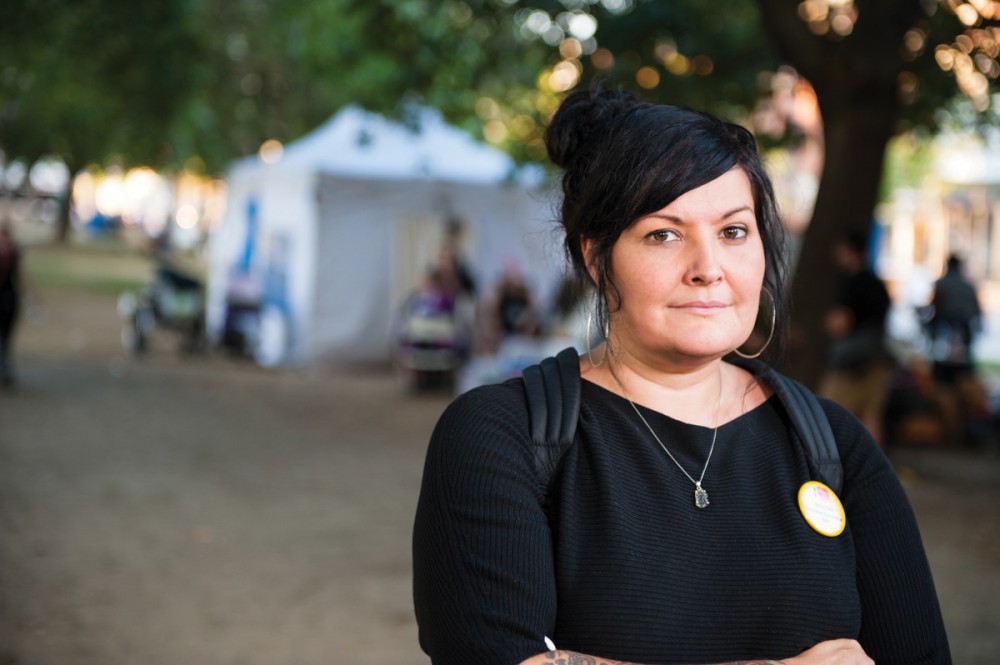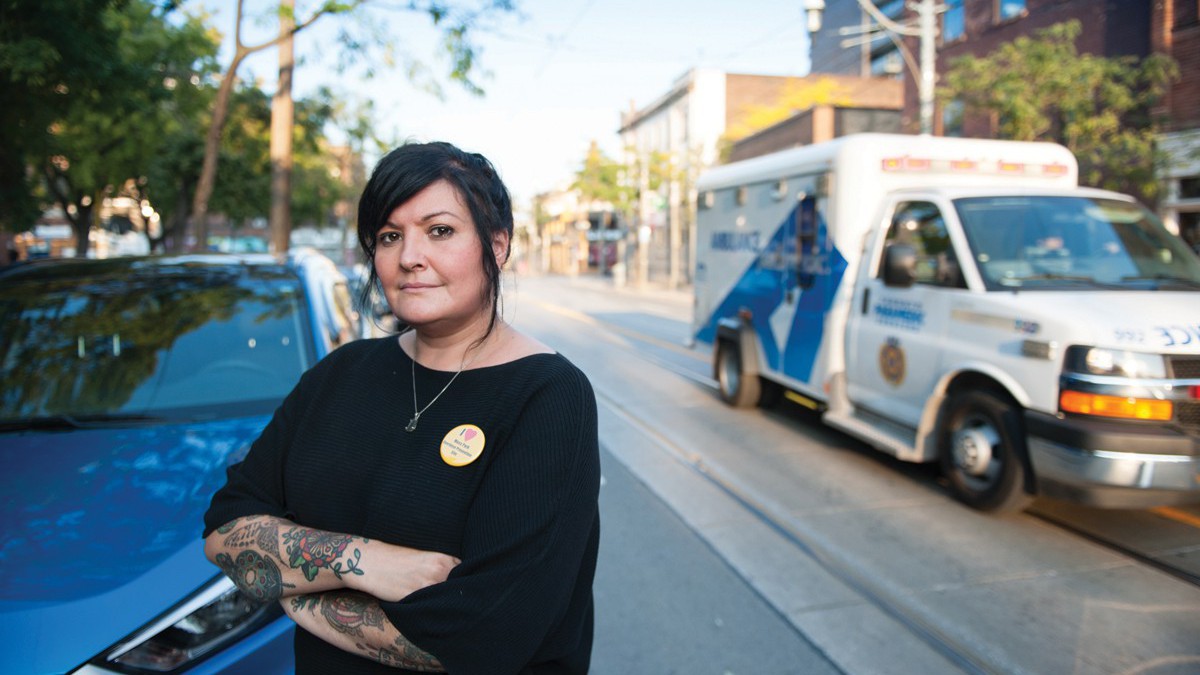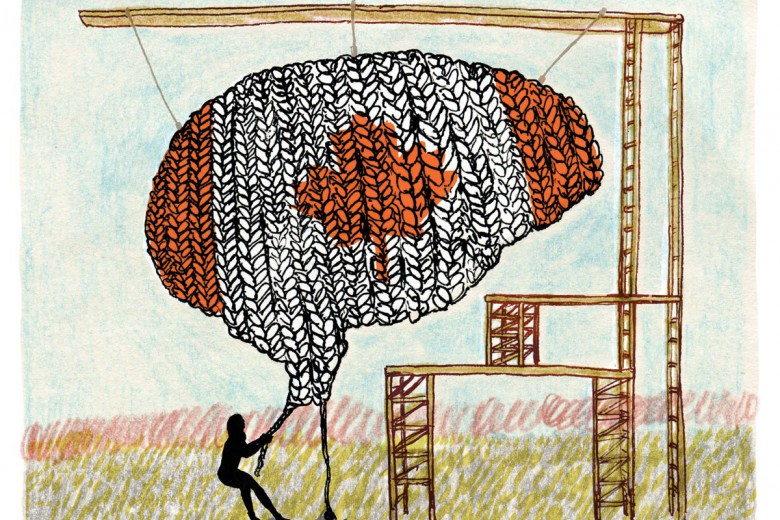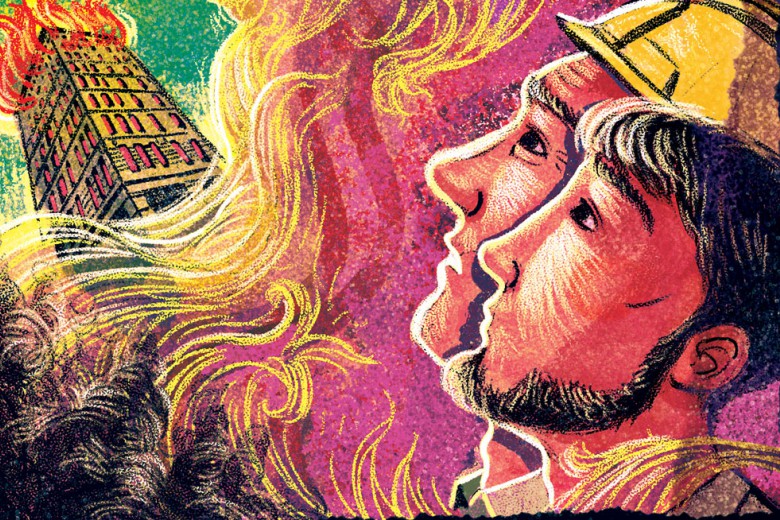I’m talking on the phone with Ljudmila Petrovic as she walks in Vancouver on a Sunday morning. Suddenly she stops and I can hear her ask someone on the sidewalk, “Are you okay? Did someone call an ambulance?”
After she makes sure that the person is okay, she apologizes for the interruption and returns to our conversation like the incident is an everyday occurrence. Petrovic is a support worker who works in a long-term residential housing building in Vancouver’s Downtown Eastside, a long-time epicentre for drug use in the city.
Petrovic tells me she is exhausted and lives in constant fear of finding one of her clients dead. Every time she opens a door for a health check or goes into the bathrooms at work, the worst-case scenario flashes through her mind. She has recurring nightmares of people dying.
There are things she’s seen that she can’t shake. The image that sticks with her the most is from one day when a client died in her building. The woman’s body was covered with a sheet as it was being carried out of the building.
“And two of the closest friends of the woman that had passed away walking behind her holding each other and just wailing at me,” recalls Petrovic. “The echoes of their crying in the building and everything else silent because everybody knew.”
Petrovic had known the woman for a year and a half, since she started working at the building.
“In a lot of ways it is a personal loss because we do know them very well and care very deeply about the people that we work with,” says Petrovic. “We have inside jokes with my clients and you tease them about stuff. You do greatly miss a lot of people that have passed.”
According to Health Canada, at least 2,458 apparent overdose deaths occurred across the country in 2016. This number underestimates the scale of the crisis, though, as the estimate is based in part on outdated data from Ontario and does not include numbers for Quebec.
“You’re trying to do the best you can but everyone is just so exhausted of the constant fear of losing so many people around them.”
“It’s been described as a war zone and it’s, I think, a very accurate description of this fear that is constantly looming over the community,” says Petrovic. “So you’re trying to do the best you can but everyone is just so exhausted of the constant fear of losing so many people around them, and that takes a huge emotional toll on people whose job it is to support the people in the community.”
“We can’t go on for much longer”
Employed by community agencies, social housing providers, neighbourhood health centres, or municipal social services, workers like Petrovic are on the front line of the overdose epidemic. B.C.’s largest public-sector union, the B.C. Government and Service Employees’ Union (BCGEU), represents front-line workers working in community health and social services across the province.
In December 2016, the union launched a workplace survey of those members who were responding to the fentanyl crisis. Over 250 people responded with gut-wrenching testimonials of life on the front line.
The survey found that front-line workers were doing the job of first responders like paramedics and firefighters in reversing overdoses. Because of this, the union argued, front-line workers should be given the same support as other first responders, including access to professional counselling.
Paramedics employed by B.C. Emergency Health Services (BCEHS), for example, have a small entitlement – $100 – in their collective agreement to pay for counselling services. In addition, they are provided short-term counselling, sessions with a BCEHS psychologist, and access to a critical incident stress management program. Debrief sessions with a psychologist are held within eight hours of a major incident and employees can request assistance from a critical-incident peer team at any time.
Peer-to-peer counselling was also mentioned in the BCGEU survey. Called a “stop gap measure,” the report said peer counselling was proven to be effective when paired with professional counselling. BCGEU recommended that peer counselling networks be established across multiple work sites where there were overdoses.
“How do I as a front-line worker start to deal with seeing those in the Downtown Eastside that have become associates, friends, and common faces lying in the alleys suffering from overdoses or death?” asks Billy Smith on the union’s website. “It is definitely the toughest situation I have experienced personally. And some days I would rather call in sick than chance finding another body at my back door.”
The union also found that while 40 per cent of workers had received training in administering naloxone, front-line workers had to pay out-of-pocket for naloxone kits while officially recognized first responders such as police got the kits for free from the government.
But more counselling and more kits aren’t going to end the crisis. Surveyed front-line workers were clear that the problem isn’t fentanyl – it is a combination of poverty, homelessness, and a lack of mental health supports that is fuelling the crisis.
“People die because of the risk of police violence related to their addictions,” writes Wulfgang (Serina) Zapf, who worked at Victoria’s Cool Aid Society. “People die because they live in social housing where they are forced to use alone. People die because they do not have safe homes to use in with friends and have to be outside.”
But more counselling and more kits aren’t going to end the crisis. Surveyed front-line workers were clear that the problem isn’t fentanyl – it is a combination of poverty, homelessness, and a lack of mental health supports that is fuelling the crisis.
The union also found that the crisis wasn’t limited to Vancouver, but was a province-wide problem. The report called for mobile overdose prevention units and safe injection sites across suburban and rural areas of B.C.
“We are the support to those impacted, but we are also enduring the grief and loss associated with losing people we care for,” writes Laurel Scott on the BCGEU website. “We can’t go on for much longer. We often don’t have the support needed so we can continue to provide the much needed services to our communities. Then what?”
Breaking rules to save lives
In 2013, outside the South Riverdale Community Health Centre (SRCHC), a dozen blocks east of Toronto’s downtown core, a drug users’ memorial was erected by the COUNTERfit Harm Reduction Program, a “community-based, drug-user-driven project” that provides services to people who use illegal drugs in the Riverdale area. As people have died from overdoses, their names have been added to the memorial. In four short years, they ran out of room. They had to install an additional pole to accommodate the list of names, which is growing daily. In August, Ontario released data showing that 865 people died in Ontario from opioids in 2016 – an increase of 19 per cent since 2015.
The memorial “remembers all people who have died as a result of the War on Drugs.” But, as in any war, there are casualties who remain invisible. The drug war is having a profound effect on the mental health of those on its front line.
Zoë Dodd is a fiery, outspoken harm reduction worker who has coordinated the hepatitis C harm reduction program at SRCHC since 2006. She has lost four co-workers and other friends in Canada’s overdose crisis in the past year alone. After her co-worker Raffi Balian died of an overdose in February, Dodd had to take time off work due to the trauma. She had lost another co-worker, Cameron, just two months before that. Losing Raffi was too much for her.
“I came to work and I just lost it,” recalls Dodd. “I was yelling, ‘We’re fucking losing!’ To lose Raffi I felt we were just losing the battle, everyone’s just going to die.”
Balian had worked with the SRCHC since 1998 and was a pillar in the community of harm reduction workers, both in Toronto and internationally. Dodd says that she started working at SRCHC because of Balian, after she met him at a safer crack use coalition meeting.
“He was an out drug user and that, for me, was pretty amazing. That he wasn’t hiding this thing, because I also use drugs and I was [thinking] ‘Oh, so many people hide that they use drugs and it’s so normal.’”
Balian was a strong proponent that “drug users are essential to their own struggle” and Dodd says she liked him because “he was willing to break rules for the lives of people who use drugs.”
Before naloxone was available without a prescription, explains Dodd, Balian was bringing it in from the United States, smuggling it in by the duffle bag and distributing it in Canada through unofficial networks of drug users and even dealers. He would bring up people from the U.S. to train drug users on overdose prevention and how to administer naloxone. Before the SRCHC became sanctioned to give out naloxone kits, Dodd estimates that up to 10,000 vials were distributed in large part due to Balian’s efforts.
“He was so proud of how we didn’t have that many overdoses in our community for a long time. If he was alive today he would be really sad to hear how many people have died,” says Dodd. “I think that’s why so many of us were angry at him when he overdosed and died.”
Balian was attending a supervised injection site meeting in Vancouver to give a presentation when he overdosed and died in his hotel room after using fentanyl.
Dodd says that Balian was an experienced drug user and it was not unusual for him to use fentanyl. Knowing the risks, he first used at a supervised injection site, but overdosed when he later used in his hotel room that night.
“I don’t think I’ve ever felt that dark in my life. With that intense grief, it felt like a pit that I was never going to climb out of,” says Dodd. “I’ve never felt like that before. It was hell.”
“The bodies keep mounting”
A 2016 article in the Journal of Community Safety and Well-Being showed that 26 per cent of paramedics experience post-traumatic stress disorder (PTSD) in their lifetime, almost three times the rate in the general population. First responders are also struggling with the pressure of the overdose crisis. But unlike first responders, front-line workers often spend months, if not years, working with specific drug users. This makes the deaths more like a friend dying than a patient.
“We become an extension of their lives,” says Dodd. “We organize people’s funerals, we go identify their bodies, we do everything. We go clean people’s homes out, contact their next of kin, so we end up doing a lot of emotional labour.”
The Canadian Mental Health Association (CMHA) says that some of the symptoms of trauma that front-line workers like Dodd and Petrovic are describing, such as recurring nightmares, could be part of PTSD.
A study sponsored by the Calgary Homeless Foundation and published by professors at the University of Calgary and Athabasca University showed that 36 per cent of front-line workers reported symptoms of PTSD. In Burnout and PTSD in Workers in the Homeless Sector in Calgary, 28 per cent of respondents said they needed additional support like mental health days, additional staff, more training, and more recognition by management of when additional support is needed. The study noted that workers were reporting both direct trauma symptoms and those as a result of working with traumatized people, contributing to the high rates of PTSD symptoms in front-line workers.
In addition to support groups and medication to deal with post-traumatic stress, the CMHA recommends professional counselling in the form of cognitive-behavioural therapy, which has been shown to be effective for PTSD. However, many front-line workers are unable to access services like counselling. Contract work with part-time and casual hours is common in the field, leaving many of those most in need of mental health support without health benefits they can access. Workers could pay for these services out of their own pocket, but with starting wages as low as $15.75 per hour at some agencies, professional counselling is out of reach for many.
“After so many deaths, in May of last year I went off work for a couple of weeks because I had been coping in ways that weren’t very helpful with my stress and realized that workers needed to come together,” says Dodd, who helped create the Frontline Worker Support Group in Toronto. “I always want these things to be already built and I could just join them but they don’t exist.”

The group meets regularly and gives front-line workers from different workplaces a space to talk with each other. Recently, Dodd started facilitating a pottery night for the group.
“I was super-obsessed with pottery,” says Dodd, who started taking a pottery class in January. “What I love about it is that you can’t think about anything else but creating something. For me that’s what I needed. I was trying meditation, I was going to yoga, I was exercising, but my brain wouldn’t shut off. It just kept talking to me all the time.”
In the depths of Dodd’s depression, Prime Minister Justin Trudeau appeared at a VICE town hall on the legalization of cannabis. Dodd confronted the prime minister at the event, pressing him to decriminalize all drugs, not just marijuana, and telling him, “It’s a national disaster. You are not doing enough. The bodies keep mounting.”
“I mentioned to him that I’d been off my job and had been traumatized. That was real. I was feeling like that, not leaving my bed, crying all day long, really trying to heal, feeling really sad,” recalls Dodd. “How much grief can you take? I really care about people. It’s not easy, it’s fucked, and with all the government inaction it feels like it’s not going to end.”
In mid-August, Dodd and a group of drug users, harm reduction workers, and nurses, inspired by unsanctioned sites operating in Vancouver, set up an unsanctioned overdose prevention site in Toronto’s Moss Park. Unlike supervised injection services, which have an exemption from Health Canada for Canada’s drug possession laws, the Toronto overdose prevention site opened in defiance of the criminalization of drugs.
Their action got results. Toronto police allowed the site to remain open and volunteers have been staffing it from 4 p.m. to 10 p.m. each day. The work of volunteers also got the city government moving and Toronto Public Health got a rushed approval from Health Canada for an interim supervised injection service while they worked to open three permanent sites that were already approved for the fall. Inspired by the action in Toronto, people opened an unsanctioned overdose prevention site in Ottawa.
700 doctors, and harm reduction and health-care workers signed an open letter calling on the provincial government to declare a public health emergency
Then 700 doctors, and harm reduction and health-care workers signed an open letter calling on the provincial government to declare a public health emergency, as B.C. did in April 2016. In response, the Ontario government announced that it would spend an additional $222 million over three years to address the crisis, with $10 million of that to hire more harm reduction workers. It isn’t yet clear if the funding will include new support for front-line workers struggling with mental health issues as a result of the crisis.
“We also need to be given the resources to do this work because people are traumatized,” said Dodd in July, prior to the announcement. “There’s workers I work with who are completely traumatized because they’ve reversed so many overdoses now. The drug users who are reversing it are feeling traumatized. You do a lot of work to support people but there’s no additional resources.”
In the first 37 days at the Toronto overdose prevention site, 30 overdoses were reversed. Sadly, on July 29, a woman was found dead of a suspected overdose in an apartment building’s stairwell near the park.
Blocks away, outside the SRCHC, the names of people lost to the crisis continue to be added to the drug users’ memorial. Beside a hand with the words “We miss you” and an illustration of how to roll someone into the recovery position, someone had scratched instructions for how to respond to an overdose into the metal structure: Overdosing? Naloxone, 911 and the recovery position saves lives.







